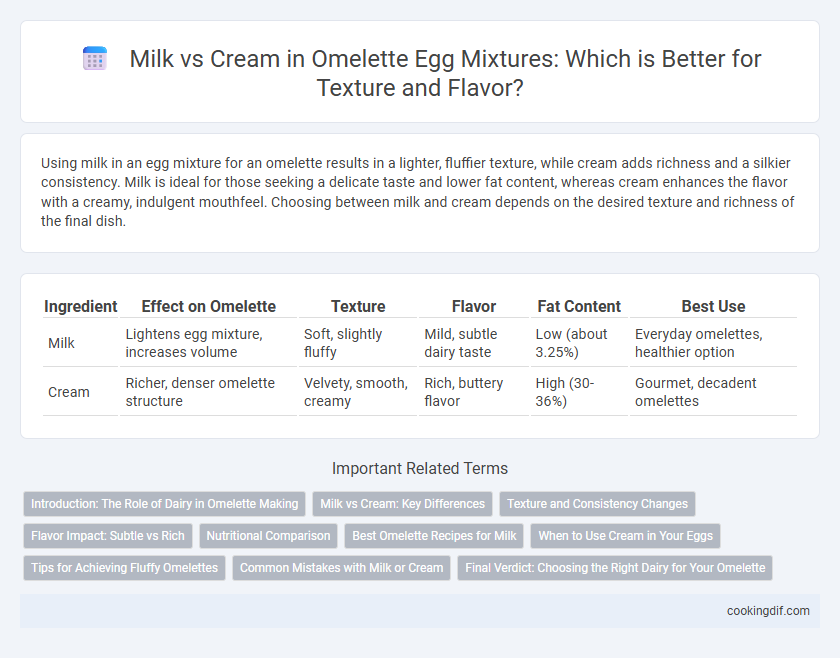Using milk in an egg mixture for an omelette results in a lighter, fluffier texture, while cream adds richness and a silkier consistency. Milk is ideal for those seeking a delicate taste and lower fat content, whereas cream enhances the flavor with a creamy, indulgent mouthfeel. Choosing between milk and cream depends on the desired texture and richness of the final dish.
Table of Comparison
| Ingredient | Effect on Omelette | Texture | Flavor | Fat Content | Best Use |
|---|---|---|---|---|---|
| Milk | Lightens egg mixture, increases volume | Soft, slightly fluffy | Mild, subtle dairy taste | Low (about 3.25%) | Everyday omelettes, healthier option |
| Cream | Richer, denser omelette structure | Velvety, smooth, creamy | Rich, buttery flavor | High (30-36%) | Gourmet, decadent omelettes |
Introduction: The Role of Dairy in Omelette Making
Milk enhances the egg mixture by adding moisture and lightness, resulting in a tender omelette with a slightly airy texture. Cream contributes higher fat content, producing a richer, silkier consistency and a more luxurious mouthfeel. Choosing between milk and cream depends on the desired richness and texture of the final omelette.
Milk vs Cream: Key Differences
Milk and cream differ primarily in fat content, with cream containing about 30-40% fat and milk ranging from 1-4%, affecting the omelette's texture and richness. Milk creates a lighter, fluffier omelette, while cream adds a denser, creamier consistency with a richer flavor profile. Using cream results in a more indulgent dish but increases calorie count, whereas milk offers a balanced, lower-fat option suitable for everyday cooking.
Texture and Consistency Changes
Adding cream to an egg mixture for omelettes results in a richer, creamier texture with a thicker consistency compared to milk, which produces a lighter and fluffier outcome. Cream's higher fat content enhances moisture retention, yielding a velvety mouthfeel and a denser structure. In contrast, milk's lower fat content allows the eggs to aerate more easily, contributing to a softer, more tender omelette.
Flavor Impact: Subtle vs Rich
Using milk in an egg mixture creates a subtle, light flavor that enhances the omelette's natural taste without overpowering it, making it ideal for simple preparations. Cream adds a rich, luxurious texture and depth of flavor, imparting a velvety smoothness that intensifies the savory profile of the eggs. Chefs often prefer cream for gourmet omelettes due to its ability to elevate the overall sensory experience with a luscious mouthfeel.
Nutritional Comparison
Milk contains fewer calories and less fat than cream, making it a lighter option for an egg mixture in omelettes. Cream is richer in saturated fat and provides more calories along with a creamier texture due to its higher fat content. Nutritionally, choosing milk results in a lower calorie omelette, while cream adds more energy and a richer mouthfeel.
Best Omelette Recipes for Milk
Milk enhances the texture of omelettes by adding moisture and creating a light, fluffy consistency, making it a preferred choice in many best omelette recipes. Using milk in the egg mixture balances richness without overwhelming the egg flavor, unlike cream which can make the omelette heavier and denser. For optimal results in fluffy omelette texture, 1 to 2 tablespoons of whole milk per 2-3 eggs is the recommended ratio in popular recipes.
When to Use Cream in Your Eggs
Cream enhances omelette texture by adding richness and a silky smooth consistency, making it ideal for decadent or restaurant-quality recipes. Use cream when you want a fluffier, more custard-like interior that holds moisture better than milk. For simple, everyday omelettes, milk suffices, but cream excels in gourmet preparations requiring a luxurious mouthfeel.
Tips for Achieving Fluffy Omelettes
Using cream instead of milk in the egg mixture adds richness and enhances the fluffiness of omelettes by increasing fat content, which helps trap air during cooking. For optimal texture, whisk eggs thoroughly with a small amount of heavy cream--about one tablespoon per two eggs--to achieve a light, creamy consistency without making the mixture too dense. Avoid overmixing and cook the omelette on medium-low heat to maintain delicate air bubbles, resulting in a tender, fluffy finish.
Common Mistakes with Milk or Cream
Using milk in an omelette mixture can lead to a watery texture due to its higher water content, while cream often results in an overly rich, dense omelette that may not cook evenly. Common mistakes include overusing milk, which dilutes the egg's flavor and prevents proper setting, and adding cream in large amounts, causing the eggs to become heavy and greasy. For optimal texture, balance is crucial: use a small amount of milk for tenderness or a light cream quantity to enhance creaminess without compromising fluffiness.
Final Verdict: Choosing the Right Dairy for Your Omelette
Cream adds richness and a velvety texture to omelettes, enhancing flavor and fluffiness, while milk creates a lighter, less dense result. For a luxurious, tender bite, opt for heavy cream, but if you prefer a delicate and lower-calorie option, whole milk is suitable. The final choice depends on personal taste and desired omelette consistency, balancing creaminess with nutrient content.
Milk vs cream for egg mixture Infographic

 cookingdif.com
cookingdif.com